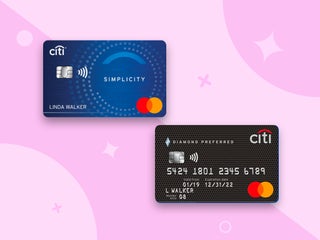Summary
If you’re looking for a balance transfer card, the Citi Simplicity® Card and the Discover it® Balance Transfer are both good options. Compare the two cards to determine which one is better for you.
The content on this page is accurate as of the posting date; however, some of our partner offers may have expired. Please review our list of best credit cards, or use our CardMatch™ tool to find cards matched to your needs.
With all of the benefits of credit card usage, it can be easy to let things like interest sneak up on you when paying your bill. If you’re struggling with high-interest debt, balance transfer cards are helpful when it comes to forming an attack plan.
Two solid balance transfer card options are the Citi Simplicity® Card and the Discover it® Balance Transfer. Which one is better? It comes down to some key components. Let’s take a closer look:
Citi Simplicity vs. Discover it Balance Transfer
 |  Discover it® Balance Transfer | |
| 0% intro APR balance transfer period | 21 months (transfers must be completed in the first 4 months) | 18 months |
| Balance transfer fee | $5 or 5% (whichever is higher) | 3% intro fee, then up to 5% (see terms) |
| 0% intro APR purchase period | 12 months | 6 months |
| Regular APR | 14.99% to 24.99% (variable) | 12.24% to 23.24% (variable) |
| Pros |
|
|
| Cons |
|
|
| Who should get this card? |
|
|
Citi Simplicity vs. Discover it Balance Transfer features
0% intro APR period
Advantage: Citi Simplicity Card
The Discover it Balance Transfer falls slightly short with its intro period for balance transfers and new purchases. While the Simplicity offers 21 months on balance transfers completed within the first four months and 12 months on new purchases, the Discover it Balance Transfer only offers six months with a 0% intro APR on new purchases and 18 months for balance transfers.
But it’s worth noting that the ongoing APR when that period ends is higher on the Citi Simplicity – 14.99% to 24.99% variable compared to 12.24% to 23.24% variable on the Discover it Balance Transfer.
Additionally, the Citi Simplicity requires that you transfer a balance within the first four months.
Balance transfer fee
Advantage: Discover it Balance Transfer
The Discover it Balance Transfer card charges a low introductory balance transfer fee of just 3%, and up to 5% for future balance transfers (see terms). The average fee among similar cards is usually 3% to 5%. You could find balance transfer cards that don’t charge a transfer fee at all, but such cards don’t typically carry rewards like the Discover it Balance Transfer does.
Citi charges a 5% balance transfer fee (or $5, whichever is higher). As we’ve mentioned, with either card, you’ll be better off completing a transfer as soon as you can because of Citi’s four-month requirement and higher balance transfer fees on the Discover it Balance Transfer after the 3% intro fee (up to 5% thereafter).
Still, Discover wins this round because you have a chance at the 3% (or $5) intro balance transfer fee, when with Citi, you will pay 5% straight out of the gate.
Additional rewards and perks
It’s a draw
One big advantage that both of these cards share is that neither charges an annual fee. That helps you focus on knocking out your high-interest balance. But that’s not all. Each has its own list of benefits as well.
The Citi Simplicity card offers you some grace with late payments – meaning any number of missed payment deadlines won’t result in any penalty fees or a penalty APR. Interest on late payments can get high, however, and you’ll see a ding on your credit report if a payment is made 30 days after it’s due.
The Discover it Balance Transfer card allows you to earn 5% cash back on up to $1,500 in purchases each quarter in rotating categories (then 1%; must enroll each quarter) and 1% cash back on all other purchases.
On top of that, Discover promises to match the rewards you earn at the end of your first year with the account. Additional perks include a free FICO credit score, no penalty for the first late payment (late payment fee up to $41 thereafter), instant account freeze and 100% U.S.-based service.
Choose Citi Simplicity if:
- You’re looking for a simple balance transfer card that doesn’t penalize you for missing a payment deadline.
- You want to finance a large purchase at 0% for 12 months (then 14.99% – 24.99% variable APR thereafter) with no annual fee and additional perks.
Choose Discover it Balance Transfer if:
- You want to transfer a balance while earning cash back for everyday spending.
- You want a balance transfer card with a potentially lower ongoing APR.
Bottom line
If the intro period is a balance transfer card’s bread and butter, both the Citi Simplicity and the Discover it Balance Transfer are generous.
However, the Citi Simplicity’s recently lengthened balance transfer offer beats the Discover it Balance Transfer by three months. The intro offer on purchases is lower than the balance transfer offer at 12 months but is still longer than the 6 months on purchases offered by the Discover it Balance Transfer.
On the other hand, Discover’s ongoing APR is slightly lower than Citi’s for these balance transfer cards. If those aren’t big determining factors for you, decide which card’s benefits might tip the scale.
Editorial Disclaimer
The editorial content on this page is based solely on the objective assessment of our writers and is not driven by advertising dollars. It has not been provided or commissioned by the credit card issuers. However, we may receive compensation when you click on links to products from our partners.






